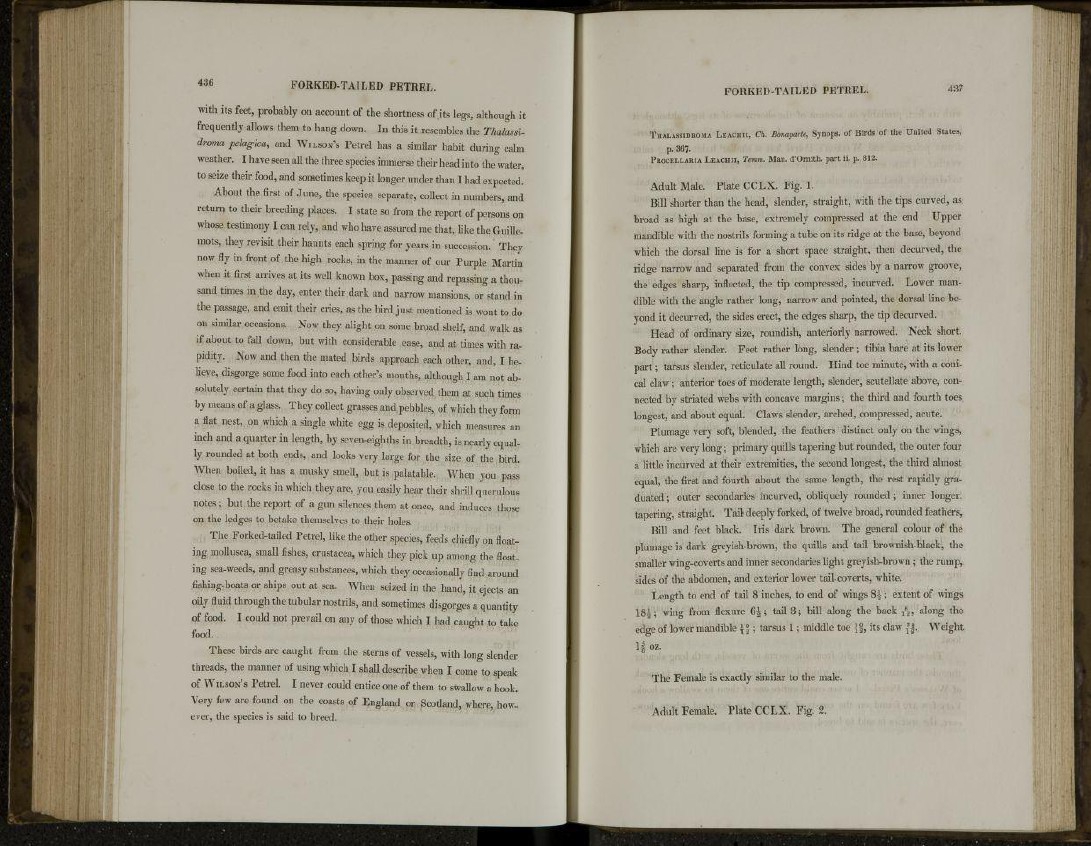
436 FORKED-TAILED PETREL.
with its feet, probably on account of the shortness of its legs, although it
frequently allows them to hang down. In this it resembles the Thalassidroma
pelagica, and WILSON'S Petrel has a similar habit during calm
weather. I have seen all the three species immerse their head into the water,
to seize their food, and sometimes keep it longer under than I had expected.
About the first of June, the species separate, collect in numbers, and
return to their breeding places. I state so from the report of persons on
whose testimony I can rely, and who have assured me that, like the Guillemots,
they revisit their haunts each spring for years in succession. They
now fly in front of the high rocks, in the manner of our Purple Martin
when it first arrives at its well known box, passing and repassing a thousand
times in the day, enter their dark and narrow mansions, or stand in
the passage, and emit their cries, as the bird just mentioned is wont to do
on similar occasions. Now they alight on some broad shelf, and walk as
if about to fall down, but with considerable ease, and at times with rapidity.
Now and then the mated birds approach each other, and, I believe,
disgorge some food into each other's mouths, although I am not absolutely
certain that they do so, having only observed them at such times
by means of a glass. They collect grasses and pebbles, of which they form
a flat nest, on which a single white egg is deposited, which measures an
inch and a quarter in length, by seven-eighths in breadth, is nearly equally
rounded at both ends, and looks very large for the size of the bird.
When boiled, it has a musky smell, but is palatable. When you pass
close to the rocks in which they are, you easily hear their shrill querulous
notes ; but the report of a gun silences them at once, and induces those
on the ledges to betake themselves to their holes.
The Forked-tailed Petrel, like the other species, feeds chiefly on floating
mollusca, small fishes, Crustacea, which they pick up among the floating
sea-weeds, and greasy substances, which they occasionally find around
fishing-boats or ships out at sea. When seized in the hand, it ejects an
oily fluid through the tubular nostrils, and sometimes disgorges a quantity
of food. I could not prevail on any of those which I had caught to take
food.
These birds are caught from the sterns of vessels, with long slender
threads, the manner of using which I shall describe when I come to speak
of WILSON'S Petrel. I never could entice one of them to sWallow a hook.
Very few are found on the coasts of England or Scotland, where, however,
the species is said to breed.
FORKED-TAILED PETREL. 437
THALASSIDKOMA LEACHII, Ch. Bonaparte, Synops. of Birds of the United States,
p. 367.
PROCELLARIA LEACHII, Temm. Man. d'Ornith. part ii. p. 812.
Adult Male. Plate CCLX. Fig. 1.
Bill shorter than the head, slender, straight, with the tips curved, as
broad as high at the base, extremely compressed at the end Upper
mandible with the nostrils forming a tube on its ridge at the base, beyond
which the dorsal line is for a short space straight, then decurved, the
ridge narrow and separated from the convex sides by a narrow groove,
the edges sharp, inflected, the tip compressed, incurved. Lower mandible
with the angle rather long, narrow and pointed, the dorsal line beyond
it decurved, the sides erect, the edges sharp, the tip decurved.
Head of ordinary size, roundish, anteriorly narrowed. Neck short.
Body rather slender. Feet rather long, slender ; tibia bare at its lower
part; tarsus slender, reticulate all round. Hind toe minute, with a conical
claw; anterior toes of moderate length, slender, scutellate above, connected
by striated webs with concave margins; the third and fourth toes
longest, and about equal. Claws slender, arched, compressed, acute.
Plumage very soft, blended, the feathers distinct only on the wings,
which are very long; primary quills tapering but rounded, the outer four
a little incurved at their extremities, the second longest, the third almost
equal, the first and fourth about the same length, the rest rapidly graduated
; outer secondaries incurved, obliquely rounded ; inner longer,
tapering, straight. Tail deeply forked, of twelve broad, rounded feathers,
Bill and feet black. Iris dark brown. The general colour of the
plumage is dark greyish-brown, the quills and tail brownish-black, the
smaller wing-coverts and inner secondaries light greyish-brown; the rump,
sides of the abdomen, and exterior lower tail-coverts, white.
Length to end of tail 8 inches, to end of wings 8«|; extent of wings
18g; wing from flexure 6^; tail 3 ; bill along the back T
8
2 , along the
edge of lower mandible \ ?2 ; tarsus 1; middle toe its claw Weight
l f o z .
The Female is exactly similar to the male.
Adult Female. Plate CCLX. Fig. 2.